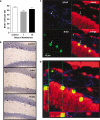Abstinence following alcohol drinking produces depression-like behavior and reduced hippocampal neurogenesis in mice
- PMID: 18563059
- PMCID: PMC2844649
- DOI: 10.1038/npp.2008.90
Abstinence following alcohol drinking produces depression-like behavior and reduced hippocampal neurogenesis in mice
Abstract
Alcoholism and depression show high degrees of comorbidity. Clinical evidence also indicates that depression that emerges during abstinence from chronic alcohol use has a greater negative impact on relapse than pre-existing depression. Although no single neurobiological mechanism can account for the behavioral pathologies associated with these devastating disorders, converging evidence suggests that aspects of both alcoholism and depression are linked to reductions in hippocampal neurogenesis. Here, we report results from a novel preclinical behavioral model showing that abstinence from voluntary alcohol drinking leads to the emergence of depression-like behavior and reductions in neurogenesis. C57BL/6J mice were allowed to self-administer ethanol (10% v/v) vs H(2)O in the home cage for 28 days. Alcohol was then removed for 1 or 14 days, and mice were tested in the forced swim test to measure depression-like behavior. After 14 days, but not 1 day of abstinence from alcohol drinking, mice showed a significant increase in depression-like behavior. The significant increase in depression-like behavior during abstinence was associated with a reduction in proliferating cell nuclear antigen (PCNA) and doublecortin (DCX) immunoreactivity in the dentate gyrus of the hippocampus indicating that both the number of proliferating neural progenitor cells (NPC) and immature neurons were reduced, respectively. The number of NPCs that were labeled with bromo-deoxyuridine (BrdU) at the beginning of alcohol exposure was not altered indicating that survival of NPCs is not linked to abstinence-induced depression. Chronic treatment (14 days) with the antidepressant desipramine during abstinence prevented both the emergence of depression-like behavior and the reduction in hippocampal neurogenesis indicating that abstinence-induced depression is associated with structural plasticity in the hippocampus. Overall, the results of this study support the conclusion that profound functional (i.e. behavioral) and structural changes occur during abstinence from alcohol use and suggest that antidepressant treatment may alleviate some of these pathological neurobehavioral adaptations.
Figures





Similar articles
-
Lobeline attenuates ethanol abstinence-induced depression-like behavior in mice.Alcohol. 2017 Jun;61:63-70. doi: 10.1016/j.alcohol.2017.01.015. Epub 2017 May 26. Alcohol. 2017. PMID: 28554528
-
Electroconvulsive Shock, but Not Transcranial Magnetic Stimulation, Transiently Elevates Cell Proliferation in the Adult Mouse Hippocampus.Cells. 2021 Aug 14;10(8):2090. doi: 10.3390/cells10082090. Cells. 2021. PMID: 34440859 Free PMC article.
-
Alcohol inhibition of neurogenesis: a mechanism of hippocampal neurodegeneration in an adolescent alcohol abuse model.Hippocampus. 2010 May;20(5):596-607. doi: 10.1002/hipo.20665. Hippocampus. 2010. PMID: 19554644 Free PMC article.
-
The impact of voluntary wheel-running exercise on hippocampal neurogenesis and behaviours in response to nicotine cessation in rats.Psychopharmacology (Berl). 2024 Dec;241(12):2585-2607. doi: 10.1007/s00213-024-06705-7. Epub 2024 Oct 27. Psychopharmacology (Berl). 2024. PMID: 39463206 Free PMC article.
-
Roles of neural stem cells and adult neurogenesis in adolescent alcohol use disorders.Alcohol. 2010 Feb;44(1):39-56. doi: 10.1016/j.alcohol.2009.11.001. Alcohol. 2010. PMID: 20113873 Free PMC article. Review.
Cited by
-
Functional role of adult hippocampal neurogenesis as a therapeutic strategy for mental disorders.Neural Plast. 2012;2012:854285. doi: 10.1155/2012/854285. Epub 2012 Dec 31. Neural Plast. 2012. PMID: 23346419 Free PMC article. Review.
-
Predictive value of depression and social support with respect to alcohol abstinence.Indian J Psychol Med. 2011 Jul;33(2):115-8. doi: 10.4103/0253-7176.92050. Indian J Psychol Med. 2011. PMID: 22345832 Free PMC article.
-
Ethanol deprivation and central 5-HT deficiency differentially affect the mRNA editing of the 5-HT2C receptor in the mouse brain.Pharmacol Rep. 2023 Dec;75(6):1502-1521. doi: 10.1007/s43440-023-00545-6. Epub 2023 Nov 3. Pharmacol Rep. 2023. PMID: 37923824 Free PMC article.
-
Effects of low-dose/high-dose-rate X-irradiation on oxidative stress in organs following forced swim test and its combined effects on alcohol-induced liver damage in mice.J Radiat Res. 2023 Jul 18;64(4):635-643. doi: 10.1093/jrr/rrad030. J Radiat Res. 2023. PMID: 37205845 Free PMC article.
-
Calcium-permeable AMPA receptor activity and GluA1 trafficking in the basolateral amygdala regulate operant alcohol self-administration.Addict Biol. 2021 Sep;26(5):e13049. doi: 10.1111/adb.13049. Epub 2021 May 5. Addict Biol. 2021. PMID: 33955100 Free PMC article.
References
-
- Aberg E, Hofstetter CP, Olson L, Brene S. Moderate ethanol consumption increases hippocampal cell proliferation and neurogenesis in the adult mouse. Int J Neuropsychopharmacol. 2005;8:557–567. - PubMed
-
- Baldwin HA, Rassnick S, Rivier J, Koob GF, Britton KT. CRF antagonist reverses the ‘anxiogenic’ response to ethanol withdrawal in the rat. Psychopharmacology (Berl) 1991;103:227–232. - PubMed
-
- Bison S, Crews F. Alcohol withdrawal increases neuropeptide Y immunoreactivity in rat brain. Alcohol Clin Exp Res. 2003;27:1173–1183. - PubMed
-
- Brown JP, Couillard-Despres S, Cooper-Kuhn CM, Winkler J, Aigner L, Kuhn HG. Transient expression of doublecortin during adult neurogenesis. J Comp Neurol. 2003;467:1–10. - PubMed
-
- Cameron HA, Gould E. Adult neurogenesis is regulated by adrenal steroids in the dentate gyrus. Neuroscience. 1994;61:203–209. - PubMed
Publication types
MeSH terms
Substances
Grants and funding
LinkOut - more resources
Full Text Sources
Medical
Miscellaneous

